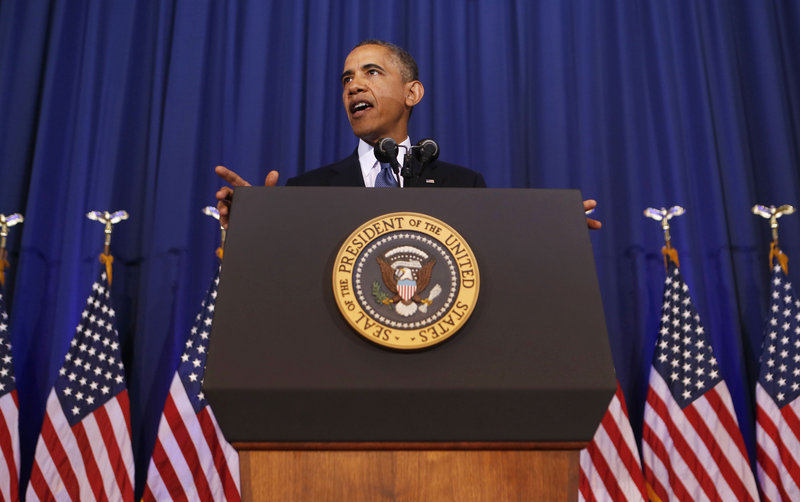President Obama on Thursday defended his administration’s use of drone strikes to kill terrorists as effective, lawful and “heavily constrained,” but he also appeared to be laying groundwork for an expansion of the controversial targeted killings.
In remarks at the National Defense University in Washington, Obama cast the use of such operations as a necessary part of an overall national defense strategy, even as he acknowledged targeted killings risk “creating new enemies” and could “lead a president and his team to view drone strikes as a cure-all for terrorism.”
He said the U.S. is at a crossroads of national security issues with a diffuse array of terrorist threats that require a recasting of a war on terror.
“Neither I, nor any president, can promise the total defeat of terror,” Obama said, contending that the threat of large-scale attacks like the Sept. 11 2001, terrorist attacks has faded as al-Qaida has been weakened, but that threats like the Boston Marathon bombing and attacks in Benghazi remain. “What we can do – what we must do – is dismantle networks that pose a direct danger, and make it less likely for new groups to gain a foothold, all while maintaining the freedoms and ideals that we defend.”
As part of that, he renewed a first term campaign promise to close the detention center at Guantanamo Bay, announcing that he’d lift a ban on detainee transfers to Yemen – homeland of half of the 166 captives at the detention facility.
The speech served to counter critics who say the drone program has been bathed in secrecy, as Obama offered more details on when the U.S. will deploy drone strikes.
But Obama’s speech appeared to expand those who are targeted in drone strikes and other undisclosed “lethal actions” in apparent anticipation of an overhaul of the 2001 congressional resolution authorizing the use of force against al-Qaida and allied groups that supported the 9/11 attacks on the United States.
In every previous speech, interview and congressional testimony, Obama and his top aides have said that drone strikes are restricted to killing confirmed “senior operational leaders of al-Qaida and associated forces” plotting imminent violent attacks against the United States.
But Obama dropped that wording Thursday, making no reference at all to senior operational leaders. While saying that the United States is at war with al-Qaida and its associated forces, he used a variety of descriptions of potential targets, from “those who want to kill us” and “terrorists who pose a continuing and imminent threat” to “all potential terrorist targets.”
The previous wording also was absent from a fact sheet distributed by the White House. Targeted killings outside of “areas of active hostilities,” it said, could be used against “a senior operational leader of a terrorist organization or the forces that organization is using or intends to use to conduct terrorist attacks.”
The preconditions for targeted killings set out by Obama and the fact sheet appear to correspond to the findings of a McClatchy review published in April of U.S. intelligence reports that showed the CIA killed hundreds of lower-level suspected Afghan, Pakistani and unidentified “other” militants in scores of drone attacks in Pakistan’s tribal are during the height of the operations in 2010-11.
Nearly 4,000 people are estimated to have died in U.S. drone strikes since 2004, the vast majority if them conducted by the CIA in Pakistan’s tribal area bordering Afghanistan.
The fact sheet also said that those who can be killed must pose a “continuing and imminent threat” to “U.S. persons,” setting no geographic limits. Previous administration statements have referred to imminent threats to the United States – the homeland or its interests.
“They appear to be broadening the potential target set,” said Christopher Swift, an international legal expert who teaches national security studies at Georgetown University and closely follows the targeted killing issue.
At the same time, new presidential guidance on targeted killings that Obama signed Wednesday appeared designed to address charges by some legal scholars and civil and human rights groups that the administration has relied on an overly broad definition of “imminent” that exceeds the international legal standard.
In his speech, Obama introduced the phrase “continuing and imminent” in what Swift saw as an effort to better define when the U.S. government can use lethal force.
“The standard for the use of force appears to be narrowing because they’ve introduced the standard of imminent and continuing,” Swift said. “Imminent means that the threat poses clear, credible and immediate risk of violence.”
Swift said he still has serious problems with the administration’s criteria for targeted killing because it has yet to publicly identify beyond the Afghan Taliban and al-Qaida’s regional affiliates the groups that it considers “associated forces” of the terrorist network and the criteria it uses to define them.
Several other experts said they also remained troubled because Obama continued to keep secret details of the procedures that the administration uses in deciding who can be targeted in drone strikes and other lethal operations off traditional battlefields.
“I don’t think anyone should feel reassured by anything that President Obama said about the use of lethal force,” said Zack Johnson of Amnesty International.
The speech came as the administration has been rattled by a series of controversies, and Obama sought to stem growing criticism of the drone program from members of Congress and civil and human rights groups that charge it’s killed hundreds of civilians and violates U.S. and international law.
Obama said the guidelines he signed Wednesday include working with other countries and only using strikes when the U.S. – or other governments – do not have the ability to capture terrorists.
He said the U.S. preference is to detain and prosecute, and that drone strikes are not used as “punishment” but to prevent attacks waged by terrorists who pose a “continuing and imminent threat to the American people.”
Send questions/comments to the editors.




Success. Please wait for the page to reload. If the page does not reload within 5 seconds, please refresh the page.
Enter your email and password to access comments.
Hi, to comment on stories you must . This profile is in addition to your subscription and website login.
Already have a commenting profile? .
Invalid username/password.
Please check your email to confirm and complete your registration.
Only subscribers are eligible to post comments. Please subscribe or login first for digital access. Here’s why.
Use the form below to reset your password. When you've submitted your account email, we will send an email with a reset code.